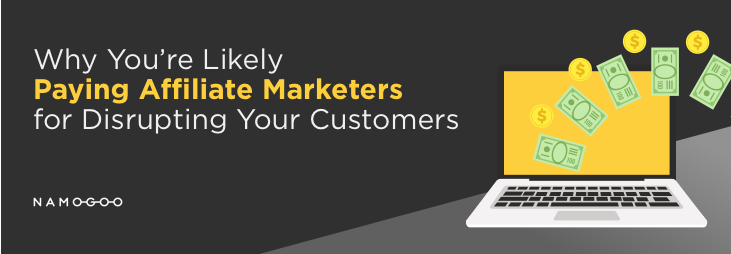Today’s retailers are increasingly waking up to the reality that Customer Journey Hijacking (CJH) is stealing many of their customers away. By causing unauthorized product promotions and offers to appear during online shopping sessions, ad injections hurts their customer experience, conversion rates, sales numbers, and total revenue.
And because 60-65% of these ads promote products sold by competing online stores, these companies are (rightly) distraught about the idea that their own websites are effectively being used against them. In addition, these retailers are worried about the impact that injected ads have on their brand reputations, especially because many of the ads promote content such as adult websites and online gambling.
But if you have an online store, there could be another, less obvious way CJH hurts your bottom line: Ad injectors may display affiliate ads for discounts on your own products. Then, when a shopper clicks on one of these ads, they will be automatically redirected back to your website. In “return” for the visitor that the ad injector has “brought” to your store, the company behind this ad injector may then charge you an affiliate fee.
In other words, there’s a good chance that ad injectors are charging you money for traffic that is already on your website.
How does affiliate marketing drive CJH?
This strategy – in which companies take money directly out of your pocket while disrupting your customer experience – is just one example of Customer Journey Hijacking. But it is not the only example, nor is it the only example in which affiliate marketing plays a key role. In fact, affiliate marketing is at the heart of the reasons CJH can be profitable.
How does CJH thrive on affiliate marketing? The answer lies in the business model of affiliate networks – a model that is supposed to rely on mutually beneficial relationships in which customers get good deals on products they want, businesses sell their goods and services to those customers, and affiliates get paid for directing interested consumers toward the products they want. By effectively connecting retailers, publishers, and shoppers, affiliate networks have been able to create a powerful platform for customer acquisition, specifically catered to the special demands of online retailers. But Customer Journey Hijacking takes advantage of that model to help certain affiliate marketers make money.
Here’s how it works:
- The consumer downloads free software such as a browser extension, program update, or mobile app that is bundled with adware and injected into their browser or device.
- The adware tracks the consumer’s online browsing activity and builds a personal profile based on their preferences, habits, and other characteristics.
- When the consumer visits an eCommerce website, the adware injects product ads, pop-ups, banners and in-text redirects on the user’s browser or device. These ads are tailored to the consumer’s personal profile in order display the most relevant and compelling product ads and promotions and can be displayed in every web page and section of the eCommerce site
That’s a business model that can be profitable for the ad injectors – whether an ad redirects a consumer from an eCommerce website to a competing website, an unrelated site, or even back to the original site. Meanwhile, the companies whose websites receive traffic acquired through CJH are typically unaware of the unscrupulous methods that have brought them prospective customers. As a result, your competitors may well be unwittingly selling products to customers stolen away from your website by injected ads.
How concerned should you be?
For online retailers of all types, the impact of Customer Journey Hijacking is dramatic, cutting conversion rates among hijacked visitors (visitors exposed to ad injections) by 12%. This results in a drop of 2-5% in online stores’ overall conversion rates and reduces their average revenue per visitor by 5-7%.
Namogoo estimates that 15%-25% of online users are exposed to injected ads – significantly changing the ways they experience the customer journey and damaging their trust and brand loyalty. All told, there are over 50,000 types of injections targeting consumer browsers and devices, including unauthorized product offers, inappropriate content, and other types of clickjacking. Product and video ads are particularly enticing and can lure customers away to competing destinations.
And even if an injected ad leads a shopper right back to your own website, the affiliate fee you pay is just one of the ways CJH hurts your company. “Retailers worldwide are subjected to affiliate hijacking attacks on a daily basis,” explained Chemi Katz, Namogoo’s CEO. “Affiliate hijacking attacks are likely to severely manipulate the customer journey, redirecting customers within the retailer’s site but not according to the designed sales funnel – potentially causing confusion and distrust.”
Yet, despite the momentous impact on customer acquisition expenses and the customer journey, many retailers are still unaware of the full picture of Customer Journey Hijacking. That’s largely because these ad injections run on the user’s device and remain invisible to traditional server-side monitoring tools, leaving retailers unable to assess the damage to their brands.
Therefore, these new and sophisticated attacks require enterprises – and online retailers in particular – to change their security paradigm. For years, we’ve been told that making certain that our servers and sites were secure was all that we needed to do in order to assure an effective customer journey. But Customer Journey Hijacking is like a thief walking into a front door while you’re standing guard at the back, and its effects can be devastating. As a result, in addition to protecting websites from the inside out in order to ensure a well-secured infrastructure, the time has come for retailers to also protect their digital real estate and their customer experience from the outside in.
How is Customer Journey Hijacking affecting your sales – and is your company paying the perpetrators directly? To see what injected ads are doing in your online store, you can get a free website analysis.



